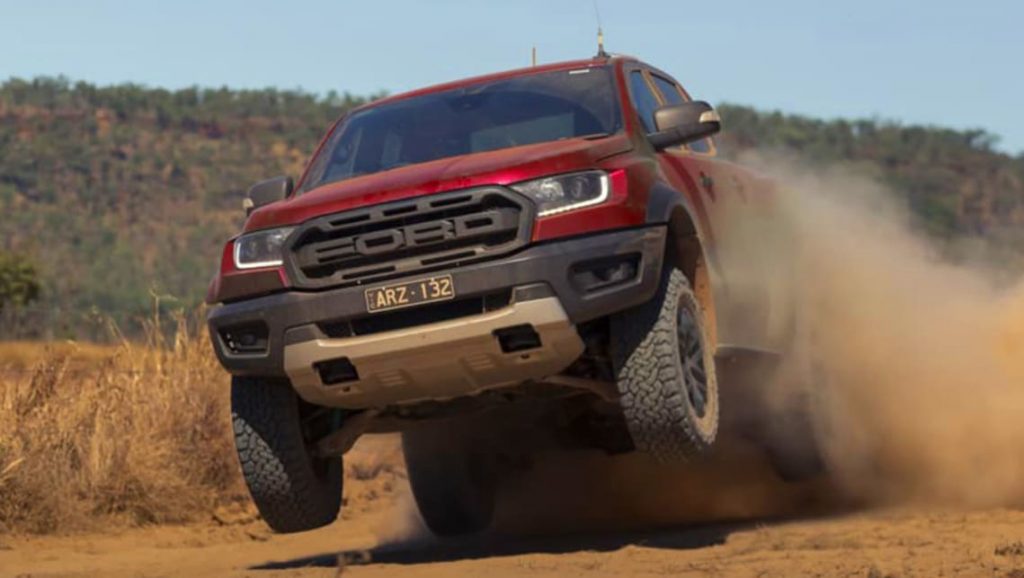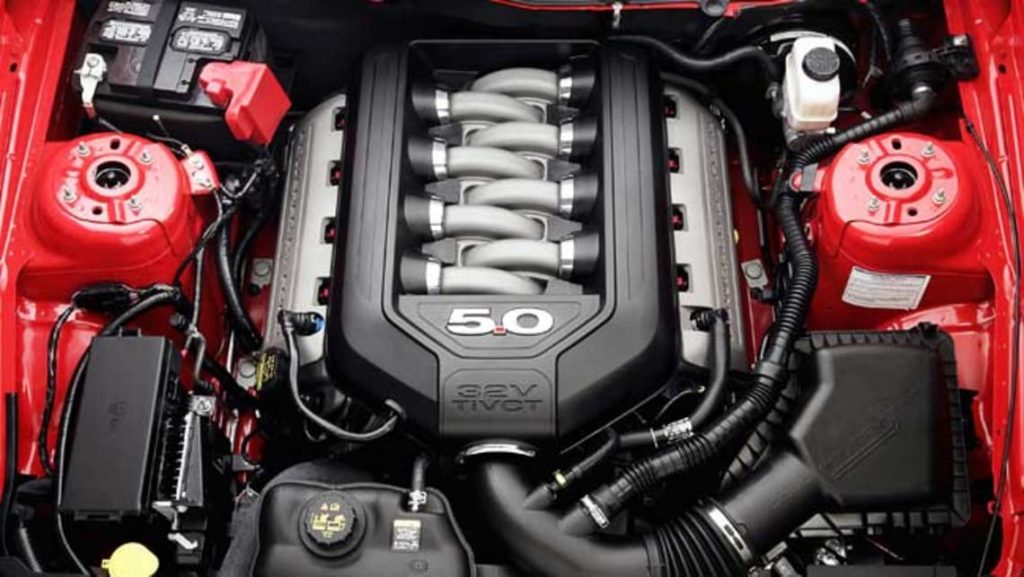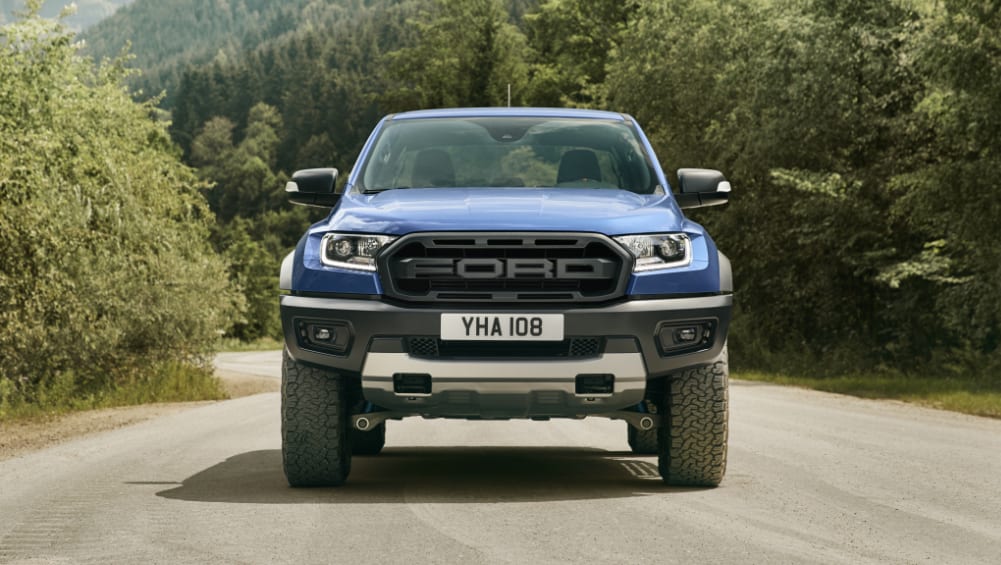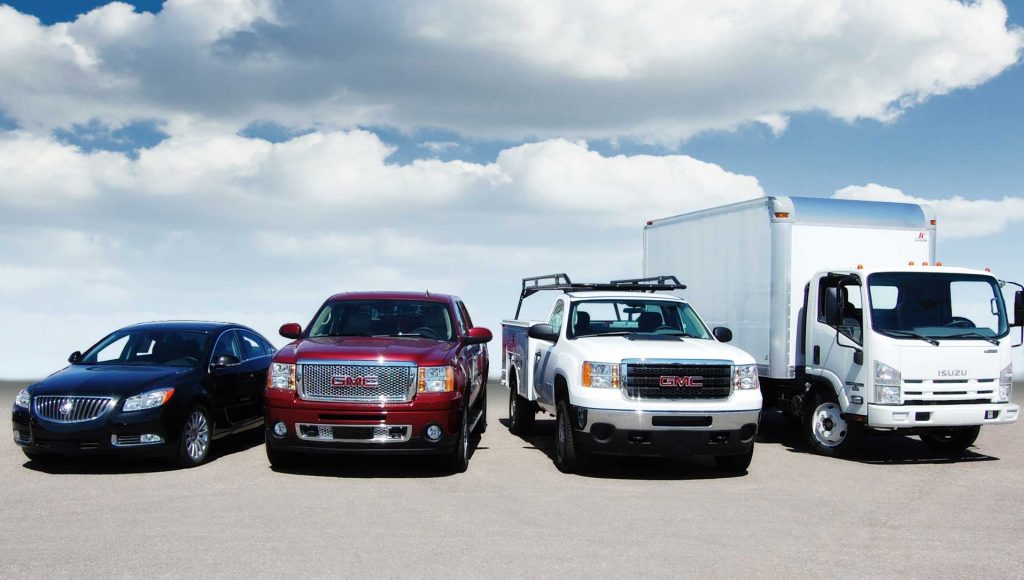
Ford realised the original small-block was nearing its engineering limit when it came under pressure to provide engines with lower emissions, greater economy, more power, and less vibration and harshness. This classic pony vehicle needed a new motor. Ford did not squander any time in designing its modular range of engines. Overhead-cam technology was initially met with scepticism, but its popularity grew as more powerful variants became available. Mustang G.T. power increased from 225 to 260 to 300 to 412 after the 5.0-liter Coyote V8 was introduced. The Shelby GT350 features the latest iteration of the Coyote engine, the VooDoo 5.2L, in addition to the older Boss 302. While rivals' engines often boast greater cubic inches, the Ford Mustang's have proven to be the most powerful in their class.
In its original 1968 incarnation, the 5.0L Ford engine was known as a 302. It offered customers who didn't want a big-block an excellent performing V-8 alternative with its 250 horsepower (SAE gross) and four-barrel carburettor. The legendary Boss 302s from 1969 and 1970, the 225 horsepower 5.0 H.O. from 1987-1993, and the Cobra 302 seen in 1993-1995 SVT Cobra Mustangs are just a few of the amazing iterations of the 302ci power unit.
The Ford Coyote crate engine is a 5.0-liter, modular V8. Using Twin Independent Variable Camshaft Timing and Cam torque actuation, it generates 412 hp despite its modest displacement. To Mustang fans, however, the Coyote engine is about so much more than that. Since 2011, these surprisingly strong powerhouses have been at the centre of the Mustang G.T., and we are now on the third generation of them.
People have many questions about the Coyote engine, and the answers are quite satisfying, ranging from the history of the engine to its name to the engineering components that allow the engine to create so much power with a relatively tiny displacement.
History of the Coyote Engine
The first Coyote motor was produced by Ford in 2010. There was a growing need for more powerful and fuel-efficient engines, and it was obvious that the technology behind these upgrades needed to make significant strides if Ford was going to stick with the tried-and-true small-block engine.
Ford began producing modular engines in the early 1990s. The adaptability of modular engines surpassed that of tiny blocks. Ford could make versions of engines for varied uses by simply switching out the machinery and doing it in a matter of hours.
Since its debut in a Lincoln Town Car in 1990, the modular engine has undergone extensive development and improvement. Ford was eager to incorporate some cutting-edge new technology into the modular layouts as well. Ford began equipping some of their engines with Twin Independent Variable Cam Timing in 2010.
Although Coyote engines would later be installed in F-150s as well, they were originally designed for the Mustang G.T. and the first car to feature one was the 2011 model year G.T. Against the Hemi in the Charger and the LS3 in the Camaro, the Coyote engine was developed.
All Mustang G.T.s and some higher-end F-150s have come standard with a Coyote engine since 2011. The Mustang and the F-150 Coyote are two quite different vehicles. The Ford Falcon, an Australian model, also utilised the Coyote.
Many Fox-body Mustang V-8 owners shortened their vehicle's identification to "five-point-oh" because of the 5.0 engine's widespread popularity. Ford, realising the potential of reviving the 5.0 designation with the 2011 G.T. engine, seized the opportunity. In late 2010, the world greeted a whole new 5.0. Fans overwhelmingly approved with the choice.
Fans also adored the G.T.'s 2011 displacement and its 400+ horsepower (412 to be exact). Ford started with a blank slate when designing the 5.0L, and the company prioritised performance, efficiency, and fuel economy throughout the entire process. Using a durable aluminium block, deep-skirting, high-flow aluminium heads, variable cam timing, a composite intake, and tuned exhaust headers, Ford created the "Coyote," which combines the greatest features of the modular range of overhead-cam engines. In addition to its compression ratio of 11:1, its lift of 0.472 inches, and its duration of 260 degrees, the standard 5.0 also has these characteristics. The 1-5-4-8-6-3-7-2 firing order and 8-quart oil pan in this engine are just the beginning.
It was at this time that Ford had the chance to reconnect with its enthusiast base by reintroducing the legendary 5.0L. This time, though, it had 412 horsepower! Ford made a fantastic engine that significantly improved upon their previous iteration in terms of pollution output, fuel efficiency, output, and vibration levels. The Ford Mustang was suddenly re-evaluated in light of this. In later years, the Coyote was refined into the Boss 302 and is now available in a new, more powerful iteration in the Shelby GT350 with a 5.2-liter "VooDoo" engine. The all-new Coyote has the potential to gain significant horsepower with the help of aftermarket components. Ford makes subtle improvements to these engines over the years, despite their superficial similarity.
Ridgeback Service Bodies is a premier ute & truck service body manufacturer for trades vehicles. Based in Melbourne, Ridgeback provides Australia's largest range of tough, quality ute & truck service bodies.
- Lift-Off Ute & Truck Service Bodies
- Fixed Ute & Truck Service Bodies
- General Service Bodies
- Trades & Fleet Solutions
The Coyote Name
Ford, as is the case with many companies, sought out potential name changes. A member of the V8 team researched Ford's past and came up with a suggestion: they should name their latest engine after a significant event in the company's history.
Ford produced its first four-valve V8 in the 1960s, and it was used in a race car. Both the 1967 and 1977 Indy 500s were won by AJ Foyt in his Coyote. In a total of 141 races, he was victorious 25 times.
The moniker Coyote was met with instant approval and became widely used.
During the early months of 2007, Ford's director of big gas and diesel engines Bob Fascetti tasked Mike Harrison with developing a new engine for the Mustang. This effort, known as the Coyote, eventually became a reality. When asked how much power their engine could produce, Harrison said 370–380 hp, but Fascetti corrected him and said 400.

Engineering Power
Ford's VCT (Variable Camshaft Timing) technology improves gas mileage and reduces pollution. Electronically increasing or decreasing the camshaft's speed as required by engine load and RPM is how variable camshaft timing is accomplished.
Depending on the application, VCT was employed either on the exhaust camshaft (for cleaner emissions) or the intake camshaft (for more horsepower). Nonetheless, most consumers are looking for increased power and lower emissions. So the challenge became figuring out how to give the intake and exhaust valves separate, yet coordinated, timing mechanisms.
The technology behind the Twin Independent Variable Camshaft Timing (TI-VCT) is an advancement on the original VCT system. Increased strength and torque were the end consequence.
Ford was able to incorporate all of this technology into a V8 for the first time in 2010 with the debut of the 5.0L Coyote engine. Coyote engines could produce up to 412 hp and 390 lb-ft of torque in its initial generation. Because of its immense strength, engineers had to figure out how to reinforce the engine's casing. To accommodate the stronger engine's higher power output without increasing the block's thickness, webbing was incorporated into the walls. If you compare the Coyote to other Ti-VCT engines released about the same time, you'll see that it uses Borg-Cam Warner's Torque Actuation (CTA) to power the camshaft instead of oil pressure to phase the cams.
The first Coyote engine used several innovative engineering techniques to provide remarkable power for its size. The original 5.0L Coyote engine produced the same amount of power as the larger 6.4L Hemi engine while having a much lower displacement.
Ford introduced the brand-new 5.0L to the Ford F150 in 2011. Taking the place of the 5.4L and 4.6L V-8s of prior models. Despite having a lower compression ratio than Mustang engines, this motor produced respectable output right out of the gate. A whopping 360 horsepower and 380 pound-feet of torque came from this brand-new F150 5.0L. This was accomplished by replacing the intake cam with a smaller one for greater torque, modifying the exhaust valve's valve jobs to improve cooling under load, modifying the exhaust manifolds, and of course, fine-tuning the engine.
Additionally new to the 2011 Mustang makeover was the Coyote V8 engine. The compression ratio of this Mustang-specific 5.0L Coyote was 11.0:1,.5 greater than that of the F150 coyote engine. The first generation Mustang's 5.0L Coyote engine produced 412 horsepower and 390 lb-ft of torque. The 2011–2012 Mustang, in contrast to the F150 Coyote, had piston cooling jets. Yet in 2013, Ford discontinued the cooling jets because "it wasn't needed."
With 11:1 compression, the first-year Coyote engine produced 412 horsepower at 6,500 revolutions per minute (rpm) and 390 pounds of torque at 4,250 rpm. Ford started with a blank sheet of paper when designing the 5.0L, and the result is an engine that excels in all three areas: power, efficiency, and fuel economy. A deep-skirted, high-flow aluminium block, high-flow cylinder heads, variable cam timing, a composite air intake, and tuned headers were used to achieve this.
The 5.0L Coyote V-8 kept up its excellent performance, gaining eight horsepower while maintaining the same amount of torque as the Mustang G.T. from 2011-2012. The head bolts on the 2013–14 Coyote Block were smaller than the previous year, and there were no oil cooling jets. For more power, the Boss 302's V8 pistons and rings have been coated in phosphorous, and the Mustang's engine tuning has been improved for 2013 and 2014.
The 2015 Mustang's 5.0 received several changes in tandem with the car's external makeover. The 12-13 Boss served as inspiration for this Coyote's 5.0L engine, which now produces 435 horsepower and 400 lb-ft of torque.
Ford's Gen 3 coyote motor is a major upgrade over previous versions of the Coyote engine. The new 5.0 has a low-pressure port fuel injection system in addition to a high-pressure direct injection system. Because of this combination, the third-generation coyote was able to increase its output without sacrificing efficiency. The new 460-horsepower, 420-foot-pound-torque Gen 3 coyote motor has quickly eclipsed its predecessor, the 435-horsepower Gen 2 motor.
At the time, this 444 horsepower, 11.0:1 compression engine was Ford's most powerful naturally aspirated offering. It wasn't easy, but Ford managed it, thanks to the major modifications made to the 5.0L engine in the G.T. The upgraded composite intake system of the Boss 302 included shorter runners to improve airflow at higher RPM. Performance was enhanced by the lighter valvetrain components, and they had no trouble maintaining the higher redline of 7500 RPM. Additionally, the Boss was outfitted with forged pistons, forged connecting rods, and a forged steel crankshaft, as well as redesigned cylinder heads with CNC-machined ports and chambers to improve airflow throughout the whole RPM range. Oil pressure was increased and lubrication lasted longer in this 302 thanks to the engine oil cooler. It goes without saying that the 5.0L Coyote was a significant improvement over the standard engine. The Boss 302 engine was developed under the codename "Road Runner," which is both fitting and evocative.
Any engine that makes it to production has to first pass through rigors testing. As Harrison elucidates, "The Boss 302 V-8 is still a production Ford engine, produced alongside the 5.0L G.T. at the Essex Engine Plant in Ontario, Canada, despite its racing pedigree and the rigours of track-day testing. This implies that it must pass or even outperform the usual durability tests that every Ford engine must endure."
His further explanation is as follows: "Ford did not have any engine test cells designed to maintain that level of acceleration for an extended period of time. Ford Racing had one, but it wasn't equipped for testing the durability of mass-produced vehicles. To prevent the dyno from breaking down after being run at full throttle for an extended period of time, we had to redesign the dyno cell with new balancers and jackshafts."
After hundreds of hours of testing at maximum power, the Boss engine proved to be superior to expectations. According to Ford, the test was the same as racing the Daytona 250 at full speed for more than 175 consecutive times.
Coyote Variants
Ford has developed numerous variants of the Coyote throughout the years.
Check out this post on MOST UNRELIABLE PICKUP TRUCKS YOU NEED TO AVOID
The Roadrunner
The expectations set by the Boss brand were especially high for the new Boss 302 versions released in 2012 and 2013. Finding a new component that could be put to the Coyote engine to make it feel like a Boss by studying Daytona prototypes.
A special intake system was utilised in Daytona race vehicles to prevent any noticeable delay when the throttle was pressed. The engine is able to "breathe" better at higher RPM, allowing the Boss to rev higher than the G.T. (which has a 7000 RPM redline) and actually producing more power. The name "Road Runner" has been applied to the engine on occasion.

The Voodoo
The Voodoo Coyote is arguably the rarest of all the different types of Coyotes. The Voodoo's flat-plane crank and 5.2L displacement set it apart from other modular V8 engines. Crankshafts with a flat-plane crank have a throw angle of zero degrees. Compared to standard V8 engines, the engine will be louder and vibrate more under these conditions, but that is the intended effect. Flat-plane cranks are commonly used in racing engines because they allow for higher engine speeds at higher RPMs.
The Shelby GT350 and GT350R were powered by Ford's Voodoo engine.
Maximum output for the Shelby GT350 and GT350R was an incredible 526 horsepower and 429 pound-feet of torque. Ford increased the bore size and switched to a flat-plane crankshaft to obtain the 5.2L displacement. Larger ports, larger valves, and higher-lift cams are just some of the upgrades to the brand-new cylinder heads. Intake ports are redesigned to be taller, the plenum is enlarged, and a 90mm throttle body is installed. We anticipate that the 5.2L V-8's storied performance will endure for years to come.
Ford's 2015 Shelby GT350 and GT350R will be the company's top naturally aspirated performance vehicles. The Shelby's 5.2-liter "VooDoo" engine, which is based on the Coyote platform, should be capable of producing over 520 hp at revs higher than 8,000 rpm. When compared to traditional engines, this level of power from a 5.2L modern production engine is very impressive.
When it comes to track performance, the Shelby GT350R Mustang leaves no stone unturned. It's a purebred street vehicle, and it uses technology and innovation to provide performance that's unmatched by all but the most dedicated fans.
The Aluminator
Coyote is responsible for yet another technological advancement, the Aluminator. Ford wanted to keep the Voodoo motor exclusive to the Shelby GT350R. They still wished for a more potent Coyote engine version to supplement the existing Ford Performance lineup. And so we have the Aluminator.
The Aluminator's crankshaft is angled at a cross plane rather than lying flat like most other engines. It's a great addition to Ford's performance lineup, with a maximum of 580 horsepower and 445 pounds of torque.
The Predator
The Predator, the newest member of the Coyote Variant family, is a modified Voodoo equipped with a cross-plane crankshaft and other goodies that make it powerful enough to compete with the upcoming 2020 GT500 Mustang.
The Predator is ridiculously powerful, with 760 horsepower and 625 lb-ft of torque.
Check out this post on THE BEST SUVS FOR A ROAD TRIP
Conclusion
Ford's crate engine, the Coyote, is a modular V8 with a 5.0-liter displacement. Thanks to its use of Twin Independent Variable Camshaft Timing and Cam torque actuation, it is able to produce 412 horsepower despite its relatively small displacement. The Mustang G.T. has relied on these engines since 2011; they are now in their third generation. Modular engines have come a long way since they were first used in a Lincoln Town Car in 1990. It wasn't until 2010 that Ford began fitting some of their engines with Twin Independent Variable Cam Timing.
Ford developed the Coyote motor with a lightweight yet strong aluminium block, high-flow aluminium heads, variable cam timing, a composite intake, and tuned exhaust headers. The Coyote engine, introduced by Ford in the Mustang in 2007, is the car manufacturer's latest and greatest V8 offering. The Coyote has cutting-edge VCT (Variable Camshaft Timing) technology, which increases fuel efficiency and decreases emissions. During the 1960s, Ford created its first four-valve V8 engine, which found its way into a racing vehicle. Ford introduced the 5.0L Coyote V8 engine for the 2010 F150 and the 2011 Mustang.
Initial Coyote generation engines generated 412 hp and 390 lb-ft of torque. The compression ratio of this engine, at 11:1, was higher than that of the Ford F150 Coyote's, at 10:1. The 5.0L Coyote engine in the 2015 Ford Mustang received an 8 HP and 400 lb-ft torque boost. In comparison to its predecessor, the Gen 2 motor that produced 435 horsepower, the Gen 3 Coyote has more power. The codename "Road Runner" was used throughout the development of the Boss 302 engine, which is both apt and evocative.
Tests of the Boss 302 V-8's longevity have been exhaustive. In other words, the engine "breathes" better at higher RPM, allowing the Boss to rev higher than the G.T. Over the years, Ford has produced many different Coyote models. In 2015, Ford's top naturally aspirated performance cars will be the Shelby GT350 and GT350R. When revved to over 8,000 rpm, the Shelby's 5.2-liter "VooDoo" engine should produce over 520 hp. A more powerful Coyote engine was still desired by Ford to complement the current Ford Performance lineup.
Content Summary
- Mustang G.T. power increased from 225 to 260 to 300 to 412 after the 5.0-liter Coyote V8 was introduced.
- The Ford Coyote crate engine is a 5.0-liter, modular V8.
- History of the Coyote Engine The first Coyote motor was produced by Ford in 2010.
- Ford began producing modular engines in the early 1990s.
- In later years, the Coyote was refined into the Boss 302 and is now available in a new, more powerful iteration in the Shelby GT350 with a 5.2-liter "VooDoo" engine.
- The all-new Coyote has the potential to gain significant horsepower with the help of aftermarket components.
- Ford was able to incorporate all of this technology into a V8 for the first time in 2010 with the debut of the 5.0L Coyote engine.
- Coyote engines could produce up to 412 hp and 390 lb-ft of torque in its initial generation.
- The first generation Mustang's 5.0L Coyote engine produced 412 horsepower and 390 lb-ft of torque.
- The 5.0L Coyote V-8 kept up its excellent performance, gaining eight horsepower while maintaining the same amount of torque as the Mustang G.T. from 2011-2012.
- For more power, the Boss 302's V8 pistons and rings have been coated in phosphorous, and the Mustang's engine tuning has been improved for 2013 and 2014.The 2015 Mustang's 5.0 received several changes in tandem with the car's external makeover.
- The 12-13 Boss served as inspiration for this Coyote's 5.0L engine, which now produces 435 horsepower and 400 lb-ft of torque.
- Ford's Gen 3 coyote motor is a major upgrade over previous versions of the Coyote engine.
- The Boss 302 V-8 is still a production Ford engine, produced alongside the 5.0L G.T. at the Essex Engine Plant in Ontario, Canada, despite its racing pedigree and the rigours of track-day testing.
- According to Ford, the test was the same as racing the Daytona 250 at full speed for more than 175 consecutive times.
- Maximum output for the Shelby GT350 and GT350R was an incredible 526 horsepower and 429 pound-feet of torque.

